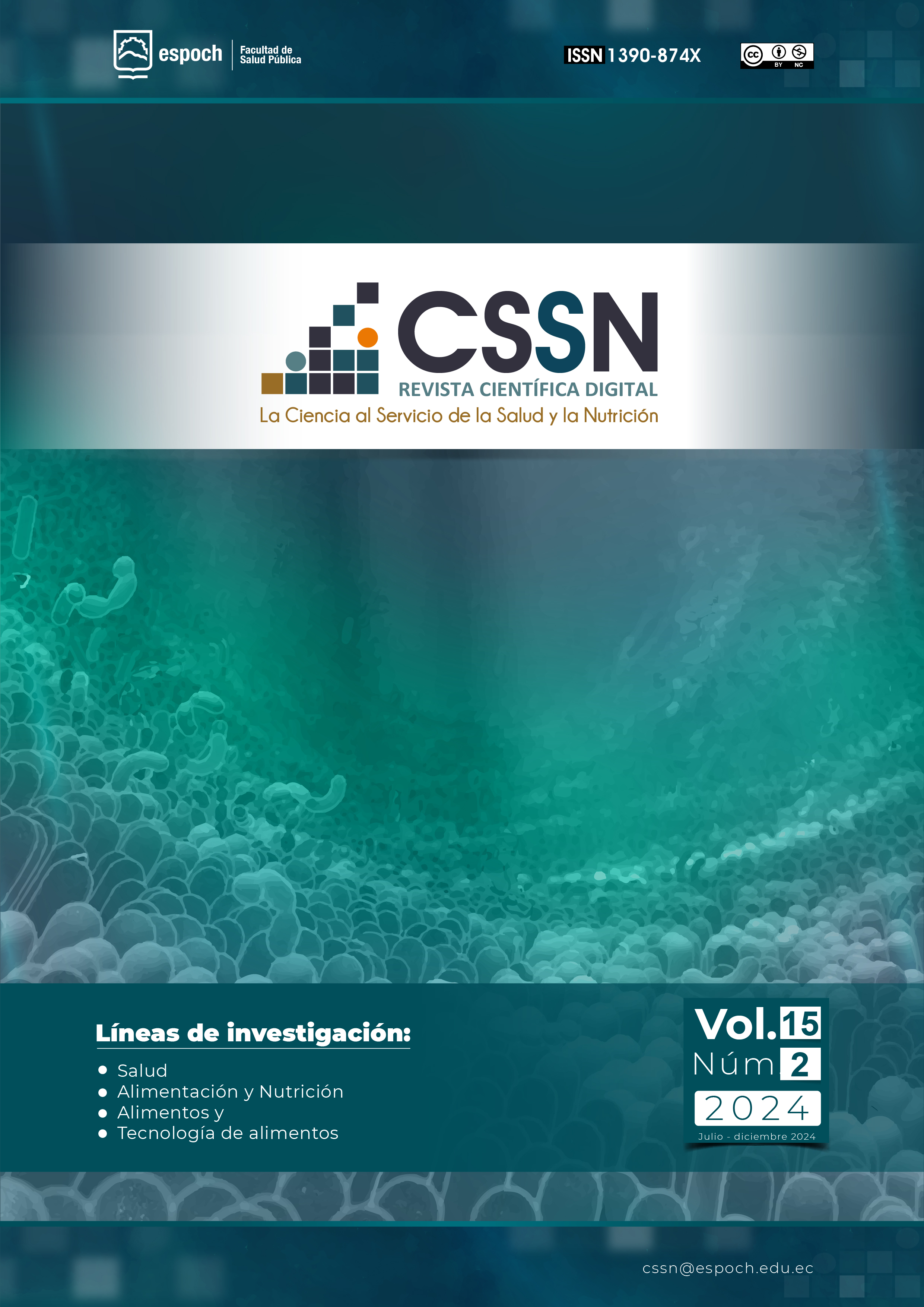CARACTERIZACIÓN DEL ÁNGULO DE FASE EN PACIENTES DIABÉTICOS
DOI:
https://doi.org/10.47187/cssn.Vol15.Iss2.355Palabras clave:
ángulo de fase, bioimpedancia eléctrica, diabetes mellitus, masa muscular, grasa visceral, tejido adiposo, complicaciones metabólicasResumen
Introducción: La caracterización del ángulo de fase, medido por la bioimpedancia eléctrica, es un marcador clínico clave en pacientes con diabetes mellitus, masa muscular, tejido adiposo y grasa visceral; permite su análisis como factor de relación directa con la respuesta tisular y celular. Objetivo: Este estudio tiene por objetivo aplicar estadística descriptiva segmentada por sexo y edad para obtener puntos de control tipo intervalo, sobre el ángulo de fase en correlación con las complicaciones metabólicas. Metodología: Se realizó un estudio transversal con un análisis correlacional de Pearson y un análisis de los componentes principales, evaluando el ángulo de fase en relación con la composición corporal y las complicaciones metabólicas derivadas de la diabetes mellitus tipo 2. Resultados: Se evaluaron 121 pacientes con diabetes mellitus tipo 2 mediante análisis descriptivo y varianza utilizando la prueba de Kolmogorov-Smirnov, considerando los componentes del
ángulo de fase en brazos, piernas y tronco, desglosados por sexo. Discusión: En este estudio se evaluó la relación entre el ángulo de fase y las complicaciones metabólicas en pacientes con diabetes mellitus tipo 2. Se estableció un intervalo de control de ángulo de fase entre 5 y 7 puntos; valores inferiores a 5 se asociaron con síndromes inflamatorios y complicaciones metabólicas. Conclusiones: El ángulo de fase se posiciona como un indicador clave para la identificación y manejo de complicaciones metabólicas en diabetes mellitus tipo 2.
Descargas
Citas
Mattiello R, Amaral MA, Mundstock E, Zatti H, Oliveira A, Machado AS, et al. Association between phase angle from bioelectrical impedance analysis and level of physical activity: systematic review and meta-analysis. Clin Nutr ESPEN. 2020;35:29-37.
Martins PC, Pereira AF, Sanches AF, Silva JC, Barreto MA, Nunes HC, et al. Phase angle as a marker for sarcopenia and functional capacity in cancer patients. Clin Nutr ESPEN. 2021;43:198-203.
da Silva BA, Matos RA, do Nascimento MZ, Vannucchi H, Jordao AA. Association between phase angle and complications in critically ill surgical patients. Clin Nutr ESPEN. 2021;45:268-75.
Souza NC, Chagas DC, Rocha SS, Pinheiro MM, da Costa EP, Leite ID, et al. Association of phase angle with health-related quality of life in hemodialysis patients. J Ren Nutr. 2016;26(2):76-80.
Fernandes SA, Copetti M, Rabito EI, da Silva DM, Trindade E, Falcão RC. Phase angle is associated with risk of malnutrition and nutritional status in hospitalized patients. Clin Nutr ESPEN. 2020;37:179-83.
Gonzalez MC, Barbosa-Silva TG, Bielemann RM, Gallagher D, Heymsfield SB. Phase angle and its determinants in healthy subjects: influence of body composition. Am J Clin Nutr. 2016;103(3):712-6.
Mattiello R, Amaral MA, Mundstock E, Zatti H, Machado AS, Almeida LB, et al. Phase angle predicts mortality in critically ill patients: a systematic review and meta-analysis. Crit Care. 2021;25(1):1-12.
Pillar N, Singer P. Phase angle in intensive care: prognostic utility and perspectives in clinical practice. Nutrition. 2020;78:110819.
Lukaski HC. Evolution of bioimpedance: a circuitous journey from estimation of physiological function to assessment of body composition and return to clinical research. Eur J Clin Nutr. 2022;76(3):319-25.
Ríos-Campuzano M, Pinzón-Cancino HA, Uscátegui-Lopera OJ, Escobar-Jaramillo SE. Bioelectrical impedance vector analysis and phase angle as indicators of functional capacity in older adults. J Geriatr Phys Ther. 2021;44(4):204-12.
Castizo-Olier J, Irurtia A, Jemni M, Carrasco-Marginet M, Fernández-García R, Rodríguez FA. Bioelectrical impedance vector analysis in athletes and physically active populations: a systematic review and future perspectives. PLoS One. 2022;17(5)
Dias KA, Soares D, Pessoa IB, Lima RM. Phase angle as a predictor of muscle strength and function in elderly: a systematic review and meta-analysis. Exp Gerontol. 2022;163:111794.
Mattiello R, Oliveira A, Manta AB, et al. Bioelectrical impedance-derived phase angle as a predictor of frailty in older adults: a systematic review and meta-analysis. Ageing Res Rev. 2023;85:101793.
Mazidi M, Karimi E, Rezaie P, Kengne AP. Phase angle and clinical outcomes: a systematic review and meta-analysis of observational studies. Arch Gerontol Geriatr. 2020;90:104108.
Szulc P, Duboeuf F, Marchand F, Chapurlat R. Phase angle as a marker of musculoskeletal health in older men. J Gerontol A Biol Sci Med Sci. 2022;77(9):1923-30.
Fukuda Y, Fukuda H, Mine T, Nakamura T. Phase angle as a marker of sarcopenia in patients with cirrhosis: a systematic review and meta-analysis. Hepatol Res. 2020;50(10):1192-1200.
Sabatino A, Regolisti G, Cosola C, Pecorini C, Naldi A, Fiaccadori E. Phase angle predicts mortality and hospitalization in hemodialysis patients. J Ren Nutr. 2022;32(6):713-20.
Mendes J, Silva FS, Oliveira JM, et al. Phase angle predicts length of stay and mortality in hospitalized patients with COVID-19: a multicenter prospective study. Clin Nutr ESPEN. 2022;48:460-7.
Garlini LM, Alberti LR, et al. Bioelectrical impedance analysis-derived phase angle in the assessment of nutrition status in heart failure patients. Nutrition. 2021;85:111136.
Santoso B, Pudjiadi AH, et al. Phase angle as a predictor of post-surgical complications in gastrointestinal cancer patients: a prospective study. J Gastrointest Surg. 2022;26(3):631-41.
Chen L-K, Woo J, Assantachai P, et al. Phase angle in Asian older adults: a critical review. Aging Dis. 2023;14(2):1056-71.
Ríos-Campuzano M, Espinosa-Coronel E, Escobar-Jaramillo SE. Bioelectrical impedance analysis for predicting complications in diabetic patients: a review of recent studies. Front Endocrinol. 2023;14:785-90.
Zhou S, Zhu H, Huang S, et al. The association between bioelectrical impedance analysis-derived phase angle and cognitive impairment in older adults: a cross-sectional study. Clin Nutr ESPEN. 2021;44:83-90.
Da Silva BAH, Vaz de Melo D. Phase angle and body composition alterations in patients undergoing dialysis: insights from bioelectrical impedance analysis. Renal Nutr. 2023; 39(3):115-25.
Gao H, Liu D, Huang L. Phase angle as a predictor of disease severity in COVID-19 patients: a prospective cohort study. Clin Nutr ESPEN. 2023;49:22-9.
Wang B, Sun Y, Zhang Z, Wang Q, Liang L, Dong X, et al. Association between phase angle and diabetic peripheral neuropathy in Type 2 diabetes patients. Endocrine. 2024; Available from: https://doi.org/10.1007/s12020-024-03689-4
Publicado
Cómo citar
Número
Sección
Licencia
Derechos de autor 2025 LA CIENCIA AL SERVICIO DE LA SALUD Y NUTRICIÓN

Esta obra está bajo una licencia internacional Creative Commons Atribución-NoComercial 4.0.









